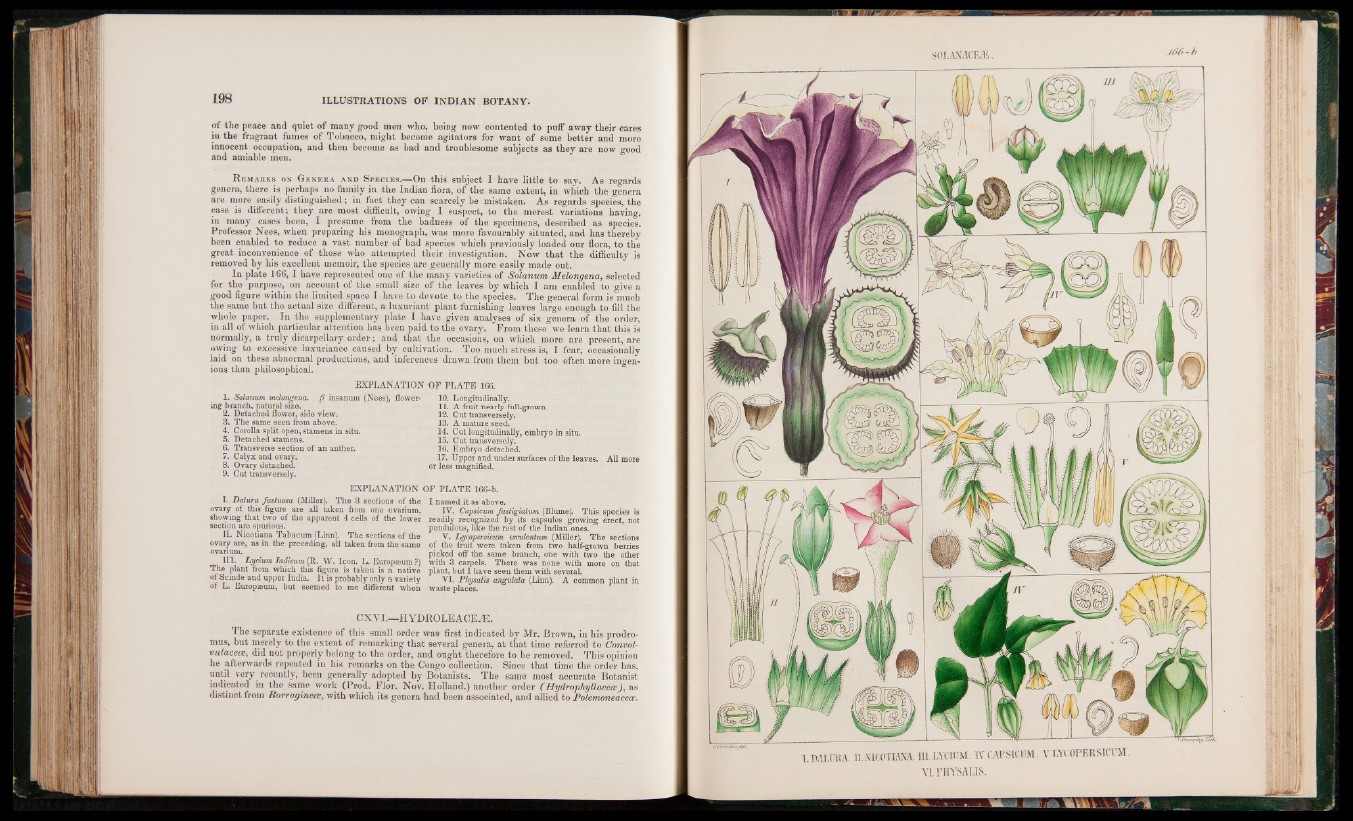
of the peace and quiet of many good men who, being now contented to puff away their cares
in the fragrant fumes of Tobacco, might become agitators for want of some better and more
innocent occupation, and then become as bad and troublesome subjects as they are now good
and amiable men.
R em a r k s on G e n e r a a n d S p e c ie s .—On this subject I have little to say. As regards
genera, there is perhaps no family in the Indian flora, of the same extent, in which the genera
are more easily distinguished; in fact they can scarcely be mistaken. As regards species, the
case is different; they are most difficult, owing I suspect, to the merest variations having,
in many cases been, I presume from the badness of the specimens, described as species.
Professor Nees, when preparing his monograph, was more favourably situated, and has thereby
been enabled to reduce a vast number of bad species which previously loaded our flora, to the
great inconvenience of those who attempted their investigation. Now that the difficulty is
removed by his excellent memoir, the species are generally more easily made out.
In plate 166, I have represented one of the many varieties of Solarium Melongena, selected
for the purpose, on account of the small size of the leaves by which I am enabled to give a
good figure within the limited space I have to devote to the species. The general form is much
the same but the actual size different, a luxuriant plant furnishing leaves large enough to fill the
whole paper. In the supplementary plate I have given analyses of six genera of the order,
in all of which particular attention has been paid to the ovary. From these we learn that this is
normally, a truly dicarpellary order; and that the occasions, on which more are present, are
owing to excessive luxuriance caused by cultivation. Too much stress is, I fear, occasionally
laid on these abnormal productions, and inferences drawn from them but too often more ingenious
than philosophical.
EXPLANATION OF PLATE 166.
1. Solanum melongena. § insanum (Nees), flowering
branch, natural size.
2. Detached flower, side view.
3. The same seen horn above.
4. Corolla split open, stamens in situ.
5. Detached stamens.
6. Transverse section of an anther.
7. Calyx and ovary.
8. Ovary detached.
9. Cut transversely.
10. Longitudinally.
11. A fruit nearly full-grown.
12. Cut transversely.
13. A mature seed.
14. Cut longitudinally, embryo in situ.
15. Cut transversely.
16. Embryo detached.
17. Upper and under surfaces o f the leaves. All more
or less magnified.
EXPLANATION OF PLATE 166-b.
I. Datura fastuosa (Miller). The 3 sections of the
ovary of this figure are all taken from one ovarium,
showing that two of the apparent 4 cells of the lower
section are spurious.
II. Nicotiana Tabacum (Linn). The sections of the
ovary are, as in the preceding, all taken from the same
ovarium.
III. Lycium Indicum (R. W. Icon. L. Europseum ?)
The plant from which this figure is taken is a native
of Scinde and upper India. It is probably only a variety
of L. Europaeum, but seemed to me different when
I named it as above.
IV. Capsicum fasligiaium (Blume). This species is
readily recognized by its capsules growing erect, not
pendulous, like the rest of the Indian ones.
V. Lycopersicum esculentum (Miller). The sections
of the fruit were taken from two half-grown berries
picked off the same branch, one with two the other
with 3 carpels. There was none with more on that
plant, but I have seen them with several.
VI. Physalis angulata (Linn). A common plant in
Waste places.
CXYI.—HYDROLEAOEAE.
The separate existence of this small order was first indicated by Mr. Brown, in his prodro-
mus, but merely to the extent of remarking that several genera, at that time referred to Convol-
vulace&i did not properly belong to the order, and ought therefore to be removed. This opinion
he afterwards repeated in his remarks on the Congo collection. Since that time the order has,
until very recently, been generally adopted by Botanists. The same most accurate Botanist
indicated in the same work (Prod. Flor. Nov. Holland.) another order ( Hydrophyllacece), as
distinct from Borraginete, with which its genera had been associated, and allied to Polemoneacece.
S0IANACEÆ. 166 -b
XDAI.URA. 11.NICOTIANA 111.LYCIUM. IV.CAPSICUM. V LYCOPERSICUM.
YLTHYSALIS.
H i